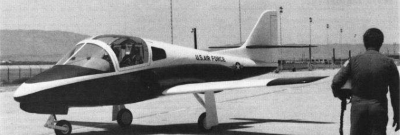The Rockwell Nova NT1 was one of five competitors in the US Air Force New Generation Trainer (NGT):

The NGT program provided a number of options, including:
- extend the life of the T-37s, possibly including modifications such as turbofan engines and modern avionics
- design and build a new aircraft built to USAF requirements —not an unlikely choice when the 600- aircraft requirement is considered;
- buy an existing offshore trainer.

ROCKWELL was proposing a twinturbofan primary trainer to meet the US Air Force requirement for a Cessna T-37 replacement. The september 2nd 1980 ROCKWELL unveils the Nova NT-1.
Among the competing NGT designs are a re-engined Cessna T-37 powered by fuel-efficient turbofans, a development of the RFB Fantrainer with side-by-side seating and twin ducted fans, and the all-new Rockwell Nova (Near-Term Optimum Value Aircraft).

Designated the Nova NT-1, the trainer has sideby-side seating and was powered by two Williams Research WR-44 1,000 lb-thrust-class medium-bypass turbofans.
Slightly smaller than the T-37, the Nova has a Supercritical airfoil wing .
The cockpit is pressurised, giving a ceiling of 40,000ft compared to 25,000ft for the unpressurised T-37.
Engines were mounted Fouga 90-style on each side of the fuselage above and behind the wing. Intakes extend forward over the wing leading edge.

Rockwell estimated that a first flight could take place in mid-1983 if the US Air Force selects a contractor and begins development late this year as planned. Production could begin in 1985 with first deliveries late that year. The potential USAF requirement is 600 aircraft. The T-37s will reach their 15,000hr life in the late 1980s.

Deficiencies identified in the existing trainer include lack of pressurisation which restricts altitude andand hence range and often prevents the aircraft from skirting bad weather. The high fuel consumption penalises range and endurance, preventing the aircraft from operating in weather which may call for a diversion. Both these factors result in decreased efficiency.
Other complaints are high noise levels, out-of-date instrumentation and difficult maintenance.



